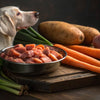Can You Cook Raw Dog Food? The Comprehensive Guide for Pet Owners
- Houndsy
Table of Contents
- Introduction
- Understanding Raw Dog Food
- The Science of Cooking Raw Dog Food
- Methods for Cooking Raw Dog Food
- Storing and Serving Cooked Raw Dog Food
- Conclusion
Introduction
Imagine preparing a meal for your dog that not only meets their nutritional needs but also caters to their specific health requirements. As pet owners, we strive to give our furry friends the best, often leading us to consider various diets, including raw food. You've likely heard the question: can you cook raw dog food? This inquiry opens the door to a deeper discussion about the implications of cooking raw dog food and how it can affect our pets' health.
Recent studies suggest that a raw diet can significantly improve a dog’s overall well-being, yet not everyone is comfortable with the idea of serving their pets cold meals. Addressing this dilemma isn't just about whether we can cook dog food—it's about understanding the nutritional balance, safety concerns, and the potential benefits and drawbacks of doing so. In this blog post, we will explore the ins and outs of cooking raw dog food, providing you with insights that may help enhance your dog’s daily feeding experience.
By the end of this post, you will have expert knowledge on the different cooking methods available, the effects of cooking on nutritional value, and practical tips to ensure safe handling and preparation of raw dog food. So, whether you're contemplating a raw diet for your dog or are interested in cooking aspects, grab a cup of coffee, relax, and let’s dive into the wonderful world of dog nutrition!
Understanding Raw Dog Food
Before we jump into the concept of cooking raw dog food, let’s have a solid understanding of what raw dog food entails and why it's become a popular choice among pet owners.
What Is Raw Dog Food?
Raw dog food consists of uncooked ingredients typically derived from meats, bones, vegetables, and fruits. This dietary approach aims to replicate the natural diet of dogs' wild ancestors, ensuring they receive essential vitamins, minerals, and nutrients. Proponents of raw diets argue that these foods offer better digestion, healthier coats, improved energy levels, and overall better health than traditional diets filled with processed kibble.
The Components of a Raw Diet
A balanced raw diet should consist of:
- Meat: Muscle and organ meats are crucial for providing amino acids necessary for overall health.
- Bones: Raw bones serve as a source of calcium and essential minerals and contribute to dental health by helping to clean dogs' teeth.
- Vegetables: While not a natural part of canine diets, vegetables can be included to enhance the nutrient profile and offer fiber.
- Fruits: Fruits (in moderation) provide various vitamins, minerals, and antioxidants.
Advantages and Disadvantages of Raw Dog Food
Advantages:
- Improved Digestion: Many pet owners report that dogs have better digestion and smaller stools with a raw diet.
- Healthier Coat and Skin: The nutrients in raw food can lead to shinier coats and healthier skin compared to traditional diets.
- Increased Energy: Dogs may exhibit more stamina and vitality on raw diets.
Disadvantages:
- Nutritional Imbalance: It can be challenging to achieve nutritional balance without proper knowledge and supplementation.
- Bacterial Concerns: Raw meat can carry harmful bacteria like Salmonella or E. coli, posing risks not only to pets but also to humans in the household.
- Cost and Time: A raw diet can be more expensive and time-consuming to prepare than commercial dog food.
Reflecting on Your Pet’s Needs
As we explore cooking raw dog food, it's essential to consider your dog's unique dietary needs. Each pet is different, and their preferences and health conditions should guide your decisions. For instance, if you have a dog with a sensitive stomach or one that's particularly picky, cooking may change their experience with food for the better. How does your dog typically respond to their meals? This reflection can help shape your approach as we move forward.
The Science of Cooking Raw Dog Food
Can You Cook Raw Dog Food?
Yes, you can cook raw dog food, and there are several methods available. However, cooking raw foods alters their nutritional properties. Heating can kill nutrients, enzymes, and probiotics essential for your dog's health. It’s crucial to strike a balance between cooking for safety and retaining the nutritional integrity of the food.
Nutritional Implications of Cooking
-
Nutrient Loss: High heat can destroy important vitamins and amino acids, which could diminish the intended benefits of a raw diet. Research shows that prolonged heat exposure generally results in nutrient degradation. For example, cooking meat typically reduces its amino acid content significantly.
-
Enzyme Alteration: Natural enzymes that aid digestion are reduced when food is cooked. These enzymes help dogs break down and utilize the nutrients efficiently, so modifying their availability can affect pets' digestive health.
-
Mineral Bioavailability: Cooking may alter the structure of minerals in food, potentially impacting their absorption. While heat-stable minerals like calcium and phosphorus remain effective, other essential compounds may be compromised during cooking.
What Happens to Raw Food When You Cook It?
Cooking raw dog food can lead to changes in the food’s texture, flavor, and smell, but its most significant impact is on nutrient retention.
- Denaturing of Proteins: Heat alters proteins and their digestibility, hence making them harder for dogs to process.
- Moisture Loss: Cooking also causes moisture loss, which may result in a drier consistency not appealing to many dogs.
- Advanced Glycation End Products (AGEs): These compounds form during cooking and can be linked to chronic diseases over time.
Maintaining Nutritional Integrity
If you choose to cook raw dog food for your canine companion, here are some strategies to retain as many nutrients as possible:
- Cook at Low Temperatures: Gentle cooking methods that maintain heat below approximately 160°F will help preserve nutrients.
- Retain Cooking Liquids: If you cook in liquid, make sure to utilize the resulting broth as it contains water-soluble vitamins that leach out during cooking.
- Supplement Nutrients as Needed: Protect your dog's health by ensuring their meals remain complete with essential nutrients that may diminish through cooking.
Methods for Cooking Raw Dog Food
Let’s look at various cooking methods that are popular among pet owners, each with its benefits and drawbacks.
1. Sautéing
Sautéing is a quick and efficient way to cook raw dog food while maintaining a good level of nutrient retention and moisture.
How to Sauté:
- Start with a small amount of broth or water in a skillet.
- Cook the desired amount of food on medium-low heat for about 3-5 minutes.
- Ensure that a slight pinkness remains inside the meat for optimal nutrient retention.
Sautéing is particularly well-suited for small portions and takes very little time, making it a preferred method for many pet owners.
2. Slow Cooking
Slow cooking provides the convenience of preparing larger batches of food with minimal hands-on time.
How to Slow Cook:
- Use a slow cooker set to low heat, and add raw ingredients into the pot.
- Add broth or a small amount of water, ensuring moisture is retained.
- Let the food cook for 4-6 hours, depending on the size of the batch and desired texture.
This method allows for a gentle cooking process that helps keep nutrients intact while providing temperature control.
3. Sous Vide Cooking
Sous vide cooking employs water baths to cook food evenly and precisely at lower temperatures.
How to Sous Vide:
- Vacuum-seal the raw dog food ingredients.
- Submerge in a water bath heated to 140°F for a designated time—typically 1.5 hours.
This method excels in preserving nutrients while ensuring the food is cooked to a safe temperature.
4. Baking
Baking is another cooking option, though it requires more vigilance to prevent overcooking.
How to Bake:
- Preheat your oven to 350°F.
- Place the food in a suitable pan and bake for about 35-45 minutes, ensuring the inside remains slightly pink to optimize nutrient retention.
While baking can result in more thorough cooking, it requires careful eyeing to avoid drying out the food.
5. First Considerations
Regardless of your chosen method, there are a few important notes to keep in mind:
- Do Not Microwave Raw Dog Food: Microwaving can lead to uneven cooking and increased nutrient loss.
- Monitor Temperature: If possible, use a meat thermometer to ensure the internal temperature reaches at least 165°F for safety without significantly compromising the food.
- Avoid Cooking Bones: Cooked bones can splinter and pose choking hazards; feed only raw or ground bones to your pets.
Storing and Serving Cooked Raw Dog Food
After preparing your dog’s food, proper storage and serving techniques are essential for maintaining quality and safety.
Proper Storage Guidelines
- Refrigeration: Store any uncooked or cooked raw pet food in the refrigerator for no more than 3-4 days.
- Freezing: For longer storage, portion out meals and freeze them; thaw in the fridge before serving. This practice helps maintain both freshness and nutritional integrity.
Serving Tips
- Serve at Room Temperature: Dogs typically prefer their food slightly warmed. If using thawed food from the fridge, consider adding a bit of warm water or bone broth to elevate the temperature.
- Monitor for Changes: Always observe your dog’s reaction to changes in diet. Monitor for any gastrointestinal issues that may arise and adjust as necessary.
Conclusion
Cooking raw dog food is a viable option, but it comes with its pros and cons. While cooking can enhance the palatability of the food for some dogs, it may also diminish essential nutrients if not done carefully. The key takeaway is that cooking should not entirely replace raw feeding, especially for healthy dogs. It should only be considered in specific situations, such as adjusting for dietary restrictions or personal preferences.
As dog lovers, we want nothing but the best for our pets. Preparing their meals should be about finding the right balance that ensures safety and optimal nutrition. Feel free to explore cooking options if you believe your dog might benefit, and don’t hesitate to consult with a veterinarian or pet nutritionist for tailored advice.
To take your feeding experience to the next level, consider simplifying the process with the Houndsy Kibble Dispenser. Designed to elevate your feeding routine while ensuring perfect portions and convenience, our dispenser is both functional and visually appealing. Order yours today!
FAQ
Q: Is it safe to cook raw dog food at home?
A: Yes, it is safe to cook raw dog food at home if you follow proper techniques and handling precautions to maintain quality and nutrition.
Q: Does cooking raw dog food kill the essential nutrients?
A: Cooking can reduce the nutritional value of raw dog food. Gentle cooking methods can minimize nutrient loss; however, some nutrients will still be lost.
Q: Can cooking eliminate harmful bacteria in raw dog food?
A: Yes, cooking raw dog food can kill harmful bacteria. However, it is essential to consider that cooking also alters the nutrients beneficial to your dog.
Q: What can I do to keep the nutrients intact while cooking?
A: Cook raw dog food at low temperatures for shorter periods, retain cooking liquids, and consider serving some meals raw to ensure optimal nutrition.
Q: How should I store cooked raw dog food?
A: Cooked raw dog food should be stored in the refrigerator for up to 3-4 days. For longer storage, freeze it in portions and thaw when needed.
By understanding the full spectrum of feeding options available to us—from raw feeding to thoughtfully cooking for our pets—we can establish a feeding routine that best supports our dogs' overall happiness and health. Just remember that whatever decision you make should align with your dog’s unique needs and preferences.













